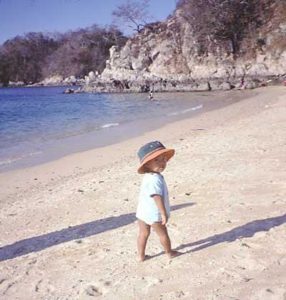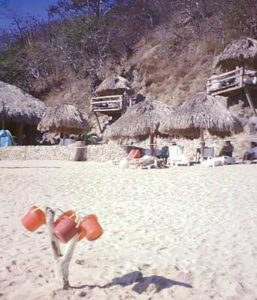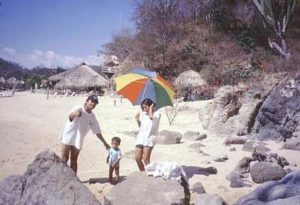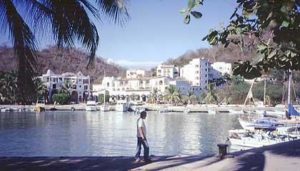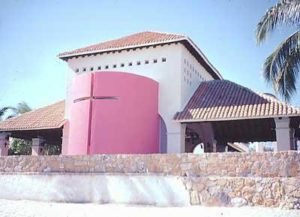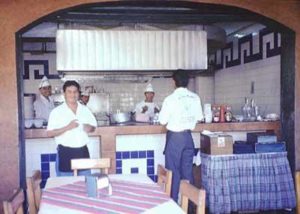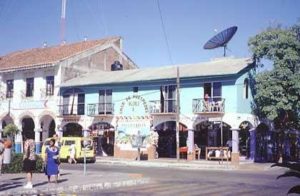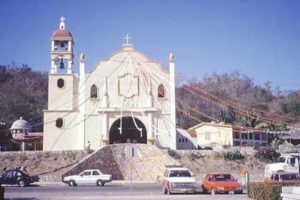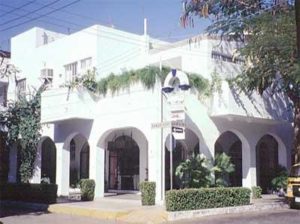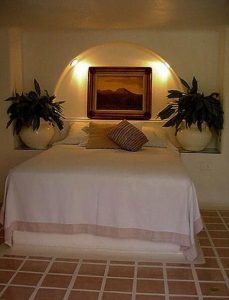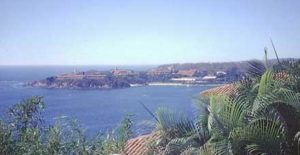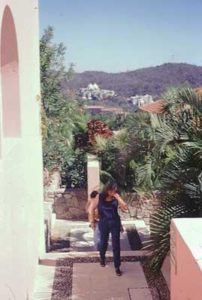Gallery: Bahias de Huatulco on Mexico’s Oaxaca coast
Bahias de Huatulco (pronounced Wa-tool-co) located on the coast of Oaxaca, ( map) about six hours from Oaxaca City by car, and approximately three hundred miles south of Acapulco, is the latest development of Fonatur, Mexico’s tourist promotion board. Rumor has it that back in the early eighties, President Miguel de la Madrid was sailing along the Oaxacan coast with friends. Coming upon pristine bays, virgin beaches and an abundance of coral reefs, he immediately recognized the potential the area held for tourism.
So began the multi-million dollar resort development. Fonatur (the Government’s Tourist Development Agency) spared no expense in planning and installing wide, landscaped roads, water treatment systems, public parks, marinas, ecological reserves and an eighteen-hole golf course. With 18 miles of rugged coastline, nine amazing bays and 36 natural beaches, Huatulco promises to be the new Mexican hot spot for vacationers.
THE BAYS
Huatulco is comprised of the small town of La Crucecita, which is the center point of the development, and nine bays: Conejos, Tangolunda, Chahue, Sta. Cruz, Entrega, Maguey, Organo, Cacaluta and San Agustin. Tangolunda is by far the best known because of the six beautiful resorts located here. Club Med, Quinta Real, Sheraton, Maeva, Gala and Camino Real Zaashila all share Tangolunda bay, making an impressive five-star hotel zone. In fact, some visitors mistakenly believe that Tangolunda is the entire development of Huatulco and never venture farther than this bay.
The Bay of Santa Cruz has a lovely marina and it is from here that most boat tours depart. Construction is now underway for a new pier large enough to dock the cruise ships which have recently added Huatulco to their itinerary. In Santa Cruz, you can find many bayfront seafood restaurants, three banks, four hotels and a delightful plaza of upscale shops and a flea market.
Chahue will soon be competing with Santa Cruz and Tangolunda as one of the most popular bays. Next year, this bay, that now has only a small marina and and beach club, will have two new hotels and a shopping center.
Maguey, Entrega and San Agustin are more remote bays known for snorkeling and diving. Seafood restaurants line their sandy shores. The bays of Cacaluta, Organo and Conejos are incredibly undeveloped; the first two accessible only by boat, bike or quadrunners.
Set back only a mile from the marina and bayfront of Santa Cruz is my home town, La Crucecita. It was originally planned by Fonatur to be the living area for workers while they constructed the hotels, restaurants and roads of the resort. Surprisingly, this village has turned into a major tourist zone with more than a dozen small hotels scattered throughout the town. Here, the zócalo (a traditional Mexican town square) offers shopping and dining as a way to unwind after a hard day’s play on the beach. A farmers’ produce and handicraft market attracts curious visitors who enjoy wandering among rows of fresh (and sometimes quite unusual) food, flowers and souvenirs.
GETTING OUT AND ABOUT
Since Huatulco isn’t a strip of high rise hotels, vacationers are often curious about how they can get from one place to another. It’s easy to get around Huatulco. Taxis are abundant and charge ten pesos (one dollar) for transportation around the town of La Crucecita and to the nearby beaches of Chauhe and Santa Cruz. Fares go up, depending on the distance, so I recommend that you determine the price before getting in the cab. Taxi drivers in Huatulco have voluntarily set prices on their fares to discourage over-charging tourists. Normally, the rates are posted on their dashboards.
There are several rental car companies in Huatulco also. An economy car, such as a Volkswagen, will run about $50 US a day, and a jeep will cost around $85. Scooters can also be rented. An hour will cost about $6, and a day approximately $30. Huatulco also has a bus line which runs from the town of La Crucecita to the Bay of Santa Cruz and then on to Tangoluna. It is basically used by the locals and costs around a quarter.
WEATHER
Huatulco enjoys approximately 300 sunny days a year and an average temperature of 85 degrees. Because of this ideal climate, combined with aquamarine crystal clear waters, the ocean is the principal attraction for tourists. Visitors can snorkel along coral reefs, sail among the bays, fish, jet ski, scuba dive or just relax under a palapa with a cold beer in hand.
Not to be outdone by the Pacific Ocean, the Sierra Madre Mountains offer their share of activities also. Just a short drive from the coast, tourists suddenly find themselves enveloped by a lush, jungle landscape as they ascend into coffee country. Here, one can spend a day at a coffee plantation, learning all about the cultivation of one of Oaxaca’s most important crops. For those travelers who are looking for a bit of adventure, an afternoon of whitewater rafting or rockclimbing is sure to cause an unforgettable impression. In La Crucecita, Tangolunda and Sta. Cruz, you can rent cars and scooters to explore the beaches and bays at a leisurely pace. Tours are available to remote beaches and coffee plantations.
LODGING
Room prices in Huatulco vary greatly depending on your pocketbook and your preferences. On Tangolunda Bay, a hotel room in high season averages about $250 to $300 dollars U.S. a night. Several of these hotels are all-inclusive. In the town of La Crucecita, a hotel room average about 25 to 30 dollars a night. Low season prices are generally about thirty percent less. High season in Huatulco begins the last week in December and continues until right after Easter; the summer months of July and August are considered high season also. There is a price increase on everything during Christmas vacation and Easter week. Tourists often complain about the high prices during these two weeks, but the demand is so great that even the highest prices are paid. Low season is in May/June and September through November. The rainy season normally starts around the end of May and continues until the end of September. The rains here are very similar to those in southern Florida, with hour-long showers during the late afternoon. November, in the opinion of this author, is the best time to travel because the rainy season is over and there are no mosquitoes. Everything is still very lush and green, prices are low, and you’ll have the beach pretty much to yourself.
EATING OUT
As with room rates, food prices also vary greatly. The five star hotels in Tangolunda all offer elegant restaurants with international cuisine with prices similar to what one would pay in the States. In Tangolunda, a pleasant steak dinner for a couple costs around fifty dollars. In La Crucecita, a nice Italian dinner for two without wine is approximately thirty dollars. Two regular fare dinners at a moderate, clean restaurant should cost about fifteen dollars. You can buy fish at a beach restaurant for approximately six dollars. A taco dinner on the street (not recommended) runs about a dollar.
GETTING THERE
Arriving at Huatulco is another story. One visitor told me that the difficulty in getting here makes Huatulco a paradise, and not another over-developed tourist area like Cancun or Acapulco. Most flights from the United States and Canada normally go through Mexico City, then connect to an hour-long flight to Huatulco. It’s this connecting flight that most visitors complain about because the price, in comparison to an American flight, is much higher. Mexicana Airlines basically has a monopoly on the Huatulco flight. Thus the tourist industry in Huatulco is trying to bring in other airlines to encourage lower prices and more travel. (So, keep your eyes peeled for alternative airlines). From November to April, several charter companies from Canada and the United States fly directly to Huatulco for very reasonable prices. During these six months, American and Canadian visitors are the mainstay of tourism.
Buses are the most common form of transportation in Mexico, and if you wish to visit Huatulco from another destination in Mexico, you should have no difficulty arriving here. From the city of Oaxaca, first class buses leave two or three times a day. The trip takes eight hours and costs about $20 US.

